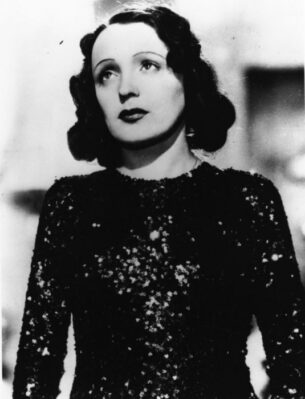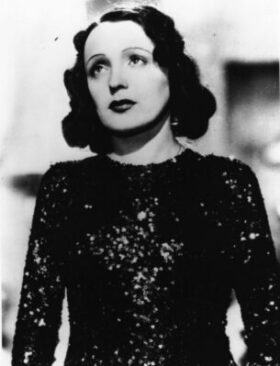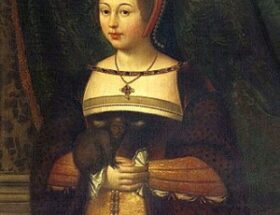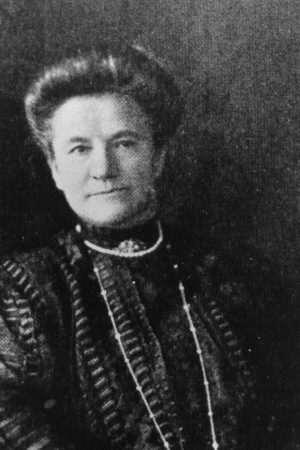
Early Life
Édith Giovanna Gassion was born on 19 December 1915 at the Hôpital Tenon, a hospital located at the 20th arrondissement of Paris, to Louis Alphonse Gassion and Annetta Giovanna Maillard.
Louis came from Normady and was a street performer of acrobatics with past experience in theatre while Annetta, known prefessionally as Line Marsa, was born in Italy with French ancestry through her father and worked as a singer and circus performer.
Édith was abandoned at birth by her mother and lived for a short time with her maternal grandmother, Emma Saïd Ben Mohamed. When her father enlisted with the French Army in 1916 to fight in World War I, he took her to his mother, who ran a brothel in Bernay, Normandy.
There the prostitutes helped look after Piaf. The bordello had two floors and seven rooms and the prostitutes were not very numerous, “about ten poor girls” as she later described. The sub-mistress of the brothel, “Madam Gaby” could be considered a little like family since she became godmother of Denise Gassion, Édith‘s half-sister born in 1931.
Édith believed her weakness for men came from mixing with prostitutes in her grandmother’s brothel. “I thought that when a boy called a girl, the girl would never refuse” she would say later.
From the age of three to seven, Édith was allegedly blind as a result of keratitis. According to one of her biographers, she recovered her sight after her grandmother’s prostitutes pooled money to accompany her on a pilgrimage honouring Saint Thérèse of Lisieux. Piaf claimed this was the result of a miraculous healing.
In 1929, at age 14, she was taken by her father to join him in his acrobatic street performances all over France, where she first began to sing in public.
In 1930, Édith met Simone “Mômone” Berteaut who became a companion for most of her life. Together they toured the streets singing and earning money for themselves. With the additional money Édith earned as part of an acrobatic trio, she and Mômone were able to rent their own place.
In 1932, she met and fell in love with Louis Dupont. Within a very short time he moved into their small room, where the three lived despite Louis’ and Mômone’s dislike for each other.
Louis was never happy with the idea of Édith‘s roaming the streets and continually persuaded her to take jobs he found for her. She resisted his suggestions, until she became pregnant and worked for a short while making wreaths in a factory.
In February 1933, 17-year-old Édith gave birth to her daughter, Marcelle (nicknamed Cécelle) at the Hôpital Tenon. Édith found it difficult to care for the child and had little parenting knowledge. She rapidly returned to street singing, until the summer of 1933, when she started performing at Juan-les-Pins, Rue Pigalle.
Following an intense quarrel over her behavior, Édith left Louis Dupont taking Mômone and Marcelle with her. The three stayed at the Hôtel Au Clair de Lune, Rue André-Antoine. During this time, Marcelle was often left alone in the room while Édith and Mômone were out on the streets or at the club singing.
Dupont eventually came and took Marcelle away, saying that if Édith wanted the child, she should come home. Like her own mother, Piaf decided not to come home, though she did pay for childcare until Marcelle‘s death from meningitis at age two.
Singing Career
In 1935, Édith was discovered in the Pigalle area of Paris by nightclub owner Louis Leplée, whose club Le Gerny’s off the Champs-Élysées was frequented by the upper and lower classes alike. He persuaded her to sing despite her extreme nervousness, which, combined with her height of only 142 centimetres (4 ft 8 in), inspired him to give her the nickname that would stay with her for the rest of her life and serve as her stage name, La Môme Piaf (Paris slang meaning “The Little Sparrow”).
Leplée taught her the basics of stage presence and told her to wear a black dress, which became her trademark apparel. Leplée ran an intense publicity campaign leading up to her opening night, attracting the presence of many celebrities, including actor and singer Maurice Chevalier.
The bandleader that evening was Django Reinhardt, with his pianist, Norbert Glanzberg. Her nightclub gigs led to her first two records produced that same year, with one of them penned by Marguerite Monnot, a collaborator throughout Piaf’s life and one of her favourite composers.
On 6 April 1936, Leplée was murdered. Édith was questioned and accused as an accessory, but acquitted. It was discovered that Leplée had been killed by mobsters with previous ties to Piaf. A barrage of negative media attention threatened her career.
To rehabilitate her image, she recruited Raymond Asso, with whom she would become romantically involved. He changed her stage name to “Édith Piaf”, barred undesirable acquaintances from seeing her and commissioned Monnot to write songs that reflected or alluded to Édith’s previous life on the streets.
In 1940, Édith co-starred in Jean Cocteau’s successful one-act play Le Bel Indifférent. The German occupation of Paris did not stop her career as she began forming friendships with prominent people, including Chevalier and poet Jacques Bourgeat.
She wrote the lyrics of many of her songs and collaborated with composers on the tunes. Spring 1944 saw the first cooperation and a love affair with Yves Montand in the Moulin Rouge.
In 1947, she wrote the lyrics to the song “Mais qu’est-ce que j’ai ?” (music by Henri Betti) for Yves Montand. She contributed greatly to the revolutionizing of the cabaret-genre. Within a year, he became one of the most famous singers in France. She broke off their relationship when he had become almost as popular as she was.
During this time, she was in great demand and very successful in Paris as France’s most popular entertainer. After the war, she became known internationally, touring Europe, the United States, and South America. In Paris, she gave Atahualpa Yupanqui (Héctor Roberto Chavero), who was a central figure in the Argentine folk music tradition, the opportunity to share the scene, making his debut in July 1950.
She helped launch the career of Charles Aznavour in the early 1950s, taking him on tour with her in France and the United States and recording some of his songs. At first she met with little success with American audiences, who expected a gaudy spectacle and were disappointed by Piaf’s simple presentation.
After a glowing 1947 review in the New York Herald Tribune by the influential New York critic Virgil Thomson her popularity grew to the point where she eventually appeared on The Ed Sullivan Show eight times, and at Carnegie Hall twice (1956 & 1957).
Édith wrote and performed her signature song, “La Vie en rose“, in 1945 and it was voted a Grammy Hall of Fame Award in 1998.
Bruno Coquatrix’s famous Paris Olympia music hall is where Piaf achieved lasting fame, giving several series of concerts at the hall between January 1955 and October 1962. Excerpts from five of these concerts (1955, 1956, 1958, 1961, 1962) were issued on record and on CD, and have never been out of print.
The 1961 concerts, promised by Édith in an effort to save the venue from bankruptcy, debuted her song “Non, je ne regrette rien“. In April 1963, Piaf recorded her last song, “L’Homme de Berlin“.
German Occupation
Édith‘s career and fame gained momentum during the German occupation of France. She performed in various nightclubs and brothels, which flourished during the 1940–1945 Années Erotiques (book title of Patrick Buisson, director of the French history channel).
Various top Paris brothels, including Le Chabanais, Le Sphinx, One Two Two, La rue des Moulins and Chez Marguerite were reserved for German officers and collaborating Frenchmen. Édith was invited to take part in a concert tour to Berlin, sponsored by the German officials, together with artists such as Loulou Gasté, Raymond Souplex, Viviane Romance and Albert Préjean.
In 1942, Édith was able to afford a luxury flat in a house in the fancy 16th arrondissement of Paris (today rue Paul-Valéry). She lived above the L’Étoile de Kléber, a famous nightclub and bordello close to the Paris Gestapo headquarters.
Piaf was deemed to have been a traitor and collaborator. She had to testify before a purge panel, as there were plans to ban her from appearing on radio transmissions. However, her secretary Andrée Bigard, a member of the Résistance, spoke in her favour after the Liberation.
According to Bigard, she performed several times at prisoner of war camps in Germany and was instrumental in helping a number of prisoners escape.
Édith was quickly back in the singing business and in December 1944, she went on stage for the Allied forces together with Montand in Marseille.
Later Romances & Marriage Life
The love of Édith‘s life, the married boxer Marcel Cerdan, died in a plane crash in October 1949, while flying from Paris to New York City to meet her. Cerdan’s Air France flight crashed in the Azores, killing everyone on board, including noted violinist Ginette Neveu.
Édith and Cerdan’s affair made international headlines, as Cerdan was the former middleweight world champion and a legend in France in his own right.
In 1951, Édith was seriously injured in a car crash along with Charles Aznavour, breaking her arm and two ribs, and thereafter had serious difficulties arising from morphine and alcohol addictions.
Édith married Jacques Pills (real name René Ducos), her first husband, in 1952 and divorced him in 1957.
In 1962, she wed Théo Sarapo (Theophanis Lamboukas), a singer, actor, and former hairdresser who was born in France of Greek descent and was 20 years her junior. The couple sang together in some of her last engagements.
Death and Legacy
Years of alcohol abuse alongside copious amounts of medications, initially for arthritic pains and later insomnia, took their toll on Édith‘s health. A series of car accidents only exacerbated her addictions and she eventually underwent a series of surgeries for a stomach ulcer in 1959.
Coupled with a deteriorating liver and the need for a blood transfusion, by 1962 she had lost a significant amount of weight, reaching a low of 30 kg (66 pounds). Drifting in and out of consciousness for several months, she died of a ruptured aneurysm due to liver failure at her villa in Plascassier, French Riviera, on 10 October 1963.
Her last words were “Every damn thing you do in this life, you have to pay for.” It is said that Sarapo drove her body back to Paris secretly so that fans would think she had died in her hometown. She is buried in Père Lachaise Cemetery in Paris next to her daughter Marcelle, where her grave is among the most visited.
Buried in the same grave are her father, Louis-Alphonse Gassion, and Théo Sarapo. The name inscribed at the foot of the tombstone is Famille Gassion-Piaf. Her name is engraved on the side as Madame Lamboukas dite Édith Piaf.
Although she was denied a funeral Mass by Cardinal Maurice Feltin because of her lifestyle, her funeral procession drew tens of thousands of mourners onto the streets of Paris and the ceremony at the cemetery was attended by more than 100,000 fans.
On 10 October 2013, fifty years after her death, the Roman Catholic Church recanted and gave Piaf a memorial Mass in the St. Jean-Baptiste Church in Belleville, Paris, the parish into which she was born.
Since 1963, the French media have continually published magazines, books, plays, television specials and films about the star often coinciding with the anniversary of her death.
In 1973, the Association of the Friends of Édith Piaf was formed followed by the inauguration of the Place Édith Piaf in Belleville in 1981. Soviet astronomer Lyudmila Georgievna Karachkina named a small planet, 3772 Piaf, in her honor.
In Paris a two-room museum is dedicated to her called the Musée Édith Piaf (on number 5, Rue Crespin du Gast).
A concert at The Town Hall in New York City commemorated the 100th anniversary of Piaf’s birth on 19 December 2015. Hosted by Robert Osborne and produced by Daniel Nardicio and Andy Brattain, it featured Little Annie, Gay Marshall, Amber Martin, Marilyn Maye, Meow Meow, Elaine Paige, Molly Pope, Vivian Reed, Kim David Smith and Aaron Weinstein.



